3-Scanning-Networks
Scanning and Enumeration
⚡︎ This chapter has practical labs for Scanning Networks (1) and Enumeration (2)
Network Scanning - Discovering systems on the network (can be hosts, switches, servers, routers, firewalls and so on) and looking at what ports are open as well as applications/services and their respective versions that may be running.
In general network scanning have three main objectives:
Scanning for live devices, OS, IPs in use.
Server at 192.168.60.30
Looking for Ports open/closed.
The server 192.168.60.30 have TCP port 23 (Telnet) running
Search for vulnerabilities on services scanned.
The Telnet service is cleartext and have many vulnerabilities published
Connectionless Communication - UDP packets are sent without creating a connection. Examples are TFTP, DNS (lookups only) and DHCP
Connection-Oriented Communication - TCP packets require a connection due to the size of the data being transmitted and to ensure deliverability
Scanning Methodology
Check for live systems - Ping or other type of way to determine live hosts
Check for open ports - Once you know live host IPs, scan them for listening ports
Scan beyond IDS - If needed, use methods to scan beyond the detection systems; evade IDS using proxies, spoofing, fragmented packets and so on
Perform banner grabbing - Grab from servers as well as perform OS fingerprinting (versions of the running services)
Scan for vulnerabilities - Use tools to look at the vulnerabilities of open systems
Draw network diagrams - Shows logical and physical pathways into networks
Use proxies - Obscures efforts to keep you hidden
Pentest Report - Document everything that you find
Identifying Targets
The easiest way to scan for live systems is through ICMP.
It has it's shortcomings and is sometimes blocked on hosts that are actually live.
Message Types and Returns
Payload of an ICMP message can be anything; RFC never set what it was supposed to be. Allows for covert channels
Ping sweep - easiest method to identify multiple hosts on subnet. You can automate ping sweep with scripting language like Bash Script (Linux) or PowerShell (Windows) or use softwares like Advanced IP Scanner, Angry IP Scanner, Nmap, etc.
ICMP Echo scanning - sending an ICMP Echo Request to the network IP address
An ICMP return of type 3 with a code of 13 indicates a poorly configured firewall
Ping scanning tools
Nmap
nmap -sn 192.168.1.0/24This command uses
-snflag (ping scan). This will perform a ping sweep on 256 IP addresses on this subnet in seconds, showing which hosts are up.
hping3
hping -1 10.0.0.x --rand-dest -I eth0-1--> ICMP mode--rand-dest--> random destionation address mode-I <interface>--> network interface name
Angry IP Scanner
Solar-Winds Engineer Toolkit
Advanced IP Scanner
Pinkie
Nmap virtually always does a ping sweep with scans unless you turn it off
Important ICMP codes
ICMP Message TypeDescription and Codes0: Echo Reply
Answer to a Type 8 Echo Request
3: Destination Unreachable
Error message followed by these codes: 0 - Destination network unreachable 1 - Destination host unreachable 6 - Network unknown 7 - Host unknown 9 - Network administratively prohibited 10 - Host administratively prohibited 13 - Communication administratively prohibited
4: Source Quench
A congestion control message
5: Redirect
Sent when there are two or more gateways available for the sender to use. Followed by these codes: 0 - Redirect datagram for the network 1 - Redirect datagram for the host
8: Echo Request
A ping message, requesting an echo reply
11: Time Exceeded
Packet took too long to be routed (code 0 is TTL expired)
Port Discovery - Basic Concepts
Knocking the door:
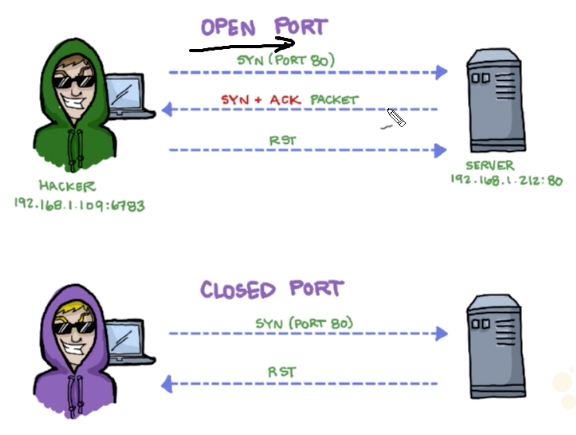
The hacker above sends a SYN packet to port 80 on the server.
If server returns SYN-ACK packet = the port is open
If server returns RST (reset) packet = the port is closed
Checking if Stateful Firewall is present:
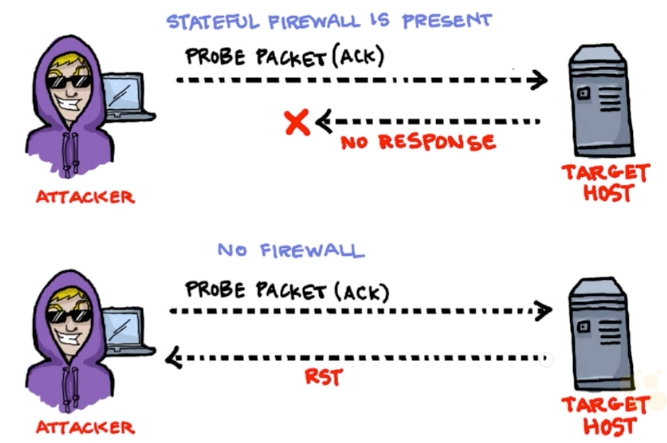
The hacker above sends an ACK segment/packet on the first interaction (without three-way handshake).
If server returns no response means that might have a stateful firewall handling proper sessions
If server returns RST packet means that have no stateful firewall
⚠️ This can be easily achieved by using nmap only.
⚠️ Keep in mind the TCP Flags & TCP Three-way handshake before use nmap!
nmap!☞ TCP Flags:
SYN
Synchronize
Set during initial communication. Negotiating of parameters and sequence numbers
ACK
Acknowledgment
Set as an acknowledgement to the SYN flag. Always set after initial SYN
RST
Reset
Forces the termination of a connection (in both directions)
FIN
Finish
Ordered close to communications
PSH
Push
Forces the delivery of data without concern for buffering
URG
Urgent
Data inside is being sent out of band. Example is cancelling a message
☞ The TCP Three-way handshake: (explained in chapter 0 - Introduction)

Nmap
⚠️ The CEH exam will definitely cover Nmap questions, about switches and how to perform a specific type of scan.
⚡︎ It is highly recommended to try out and explore the nmap in your own virtual environment; I made a couple practical labs[1] [2] [3] to help you understand the functionality of nmap.
Nmap ("Network Mapper") is a free and open source (license) utility for network discovery and security auditing. Many systems and network administrators also find it useful for tasks such as network inventory, managing service upgrade schedules, and monitoring host or service uptime. Nmap uses raw IP packets in novel ways to determine what hosts are available on the network, what services (application name and version) those hosts are offering, what operating systems (and OS versions) they are running, what type of packet filters/firewalls are in use, and dozens of other characteristics. [+]
Nmap Scan Types:
Stealth Scan
Half-open scan or SYN scan - only SYN packets sent. Responses same as full.
Useful for hiding efforts and evading firewalls
nmap -sS <target IP>
Full connect
TCP connect or full open scan. The first two steps (SYN and SYN/ACK) are exactly the same as with a SYN scan. Then, instead of aborting the half-open connection with a RST packet, krad acknowledges the SYN/ACK with its own ACK packet, completing the connection.
Full connection and then tears down with RST.
Easiest to detect, but most reliable
nmap -sT <target IP>
TCP ACK scan / flag probe - multiple methods
TTL version - if TTL of RST packet < 64, port is open
Window version - if the Window on the RST packet is anything other than 0, port open
Can be used to check filtering. If ACK is sent and no response, stateful firewall present.
nmap -sA <target IP>(ACK scan)nmap -sW <target IP>(Window scan)
NULL, FIN and Xmas Scan
⚠️ Uses FIN, URG or PSH flag.
Open gives no response. Closed gives RST/ACK
nmap -sN <target IP>(Null scan)nmap -sF <target IP>(FIN scan)Xmas Scan - Sets the FIN, PSH, and URG flags, lighting the packet up like a Christmas tree.
Responses are same as Inverse TCP scan
Do not work against Windows machines
nmap -sX <target IP>
⚠️ The key advantage to these scan types (NULL, FIN or Xmas scan) is that they can sneak through certain non-stateful firewalls and packet filtering routers.
IDLE Scan
uses a third party to check if a port is open
Looks at the IPID to see if there is a response
Only works if third party isn't transmitting data
Sends a request to the third party to check IPID id; then sends a spoofed packet to the target with a return of the third party; sends a request to the third party again to check if IPID increased.
IPID increase of 1 indicates port closed
IPID increase of 2 indicates port open
IPID increase of anything greater indicates the third party was not idle
nmap -sI <zombie host> <target IP>
Spoofing
Decoy:
nmap -Pn -D <spoofed IP> <target>This will perform a spoofed ping scan.
Source Address Spoofing:
nmap -e <network interface> -S <IP source> <target>Example -->
nmap -e eth0 -S 10.0.0.140 10.0.0.165
MAC Address Spoofing:
nmap --spoof-mac <MAC|Vendor> <target>Example -->
nmap --spoof-mac Cis 10.0.0.140
⚠️ Decoys will send spoofed IP address along with your IP address.
Firewall Evasion
Multiple Decoy IP addresses:
This command is used to scan multiple decoy IP addresses. Nmap will send multiple packets with different IP addresses, along with your attacker's IP address.
nmap -D RND:<number> <target>Example -->
nmap -D RND:10 192.168.62.4
IP Fragmentation:
Used to scan tiny fragment packets
nmap -f <target>
Maximum Transmission Unit:
This command is used to transmit smaller packets instead of sending one complete packet at a time.
nmap -mtu 8 <target>Maximum Transmission Unit (-mtu) and 8 bytes of packets.
Timing & Performance
Paranoid
Paranoid (0) Intrusion Detection System evasion
nmap <target> -T0
Sneaky
Sneaky (1) Intrusion Detection System evasion
nmap <target> -T1
Polite
Polite (2) slows down the scan to use less bandwidth and use less target machine resources
nmap <target> -T2
Normal
Normal (3) which is default speed
nmap <target> -T3
Agressive
Aggressive (4) speeds scans; assumes you are on a reasonably fast and reliable network
nmap <target> -T4
Insane
Insane (5) speeds scan; assumes you are on an extraordinarily fast network
nmap <target> -T5
UDP Scan
Most popular services runs over the TCP, but there are many common services that also uses UDP: DNS (53), SMTP (25), DHCP (67), NTP (123), NetBIOS-ssn (137), etc.
nmap -sU <target>
You also can specify which UDP port:
nmap -sU -p U:53, 123 <target>
Also you can fire up both TCP and UDP scan with port specification:
nmap -sU -sS -p U:53,123 T:80,443 <target>
List of Switches
-sA
ACK scan
-sF
FIN scan
-sI
IDLE scan
-sL
DNS scan (list scan)
-sN
NULL scan
-sO
Protocol scan (tests which IP protocols respond)
-sP or -sn
Ping scan
-sR
RPC scan
-sS
SYN scan
-sT
TCP connect scan
-sW
Window scan
-sX
XMAS scan
-A
OS detection, version detection, script scanning and traceroute
-sV
Determine only service/version info
-PI
ICMP ping
-Pn
No ping
-Po
No ping
-PS
SYN ping
-PT
TCP ping
-oN
Normal output
-oX
XML output
-n
Never do DNS resolution/Always resolve
-f
--mtu : fragment packets (optionally w/given MTU)
-D
IP address Decoy: <decoy1,decoy2[,ME],...>: Cloak a scan with decoys
-T0 through -T2
Serial scans. T0 is slowest
-T3 through -T5
Parallel scans. T3 is slowest
-F
Fast mode - Scan fewer ports than the default scan
Notes:
Nmap runs by default at a T3 level (3 - Normal).
Nmap runs by default TCP scans.
Nmap ping the target first before the port scan by default, but if the target have a firewall, maybe the scan will be blocked. To avoid this, you can use
-Pnto disable ping.If you're in LAN and you need to disable ARP ping, use:
--disable-arp-ping
You can add a input from external lists of hosts/networks:
-iL hosts-example.txt
Fingerprinting - another word for port sweeping and enumeration
➕ More Useful Information about Nmap: ➕
Switch
Example
Description
-p
nmap 192.168.1.1 -p 21
Port scan for port x
-p
nmap 192.168.1.1 -p 21-100
Port range
-p
nmap 192.168.1.1 -p U:53,T:21-25,80
Port scan multiple TCP and UDP ports
-p-
nmap 192.168.1.1 -p-
Port scan all ports
-p
nmap 192.168.1.1 -p http,https
Port scan from service name
-F
nmap 192.168.1.1 -F
Fast port scan (100 ports)
--top-ports
nmap 192.168.1.1 --top-ports 2000
Port scan the top x ports
-p-65535
nmap 192.168.1.1 -p-65535
Leaving off initial port in range makes the scan start at port 1
-p0-
nmap 192.168.1.1 -p0-
Leaving off end port in range
makes the scan go through to port 65535
2. Service and Version Detection
Switch
Example
Description
-sV
nmap 192.168.1.1 -sV
Attempts to determine the version of the service running on port
-sV --version-intensity
nmap 192.168.1.1 -sV --version-intensity 8
Intensity level 0 to 9. Higher number increases possibility of correctness
-sV --version-light
nmap 192.168.1.1 -sV --version-light
Enable light mode. Lower possibility of correctness. Faster
-sV --version-all
nmap 192.168.1.1 -sV --version-all
Enable intensity level 9. Higher possibility of correctness. Slower
-A
nmap 192.168.1.1 -A
Enables OS detection, version detection, script scanning, and traceroute
3. OS Detection
Switch
Example
Description
-O
nmap 192.168.1.1 -O
Remote OS detection using TCP/IP stack fingerprinting
-O --osscan-limit
nmap 192.168.1.1 -O --osscan-limit
If at least one open and one closed TCP port are not found it will not try OS detection against host
-O --osscan-guess
nmap 192.168.1.1 -O --osscan-guess
Makes Nmap guess more aggressively
-O --max-os-tries
nmap 192.168.1.1 -O --max-os-tries 1
Set the maximum number x of OS detection tries against a target
-A
nmap 192.168.1.1 -A
Enables OS detection, version detection, script scanning, and traceroute
4. Timing and Performance
Switch
Example input
Description
--host-timeout <time>
1s; 4m; 2h
Give up on target after this long
--min-rtt-timeout/max-rtt-timeout/initial-rtt-timeout <time>
1s; 4m; 2h
Specifies probe round trip time
--min-hostgroup/max-hostgroup <size<size>
50; 1024
Parallel host scan group sizes
--min-parallelism/max-parallelism <numprobes>
10; 1
Probe parallelization
--scan-delay/--max-scan-delay <time>
20ms; 2s; 4m; 5h
Adjust delay between probes
--max-retries <tries>
3
Specify the maximum number of port scan probe retransmissions
--min-rate <number>
100
Send packets no slower than <numberr> per second
--max-rate <number>
100
Send packets no faster than <number> per second
5. NSE Scripts
NSE stands for Nmap Scripting Engine, and it’s basically a digital library of Nmap scripts that helps to enhance the default Nmap features and report the results in a traditional Nmap output.
One of the best things about NSE is its ability to let users write and share their own scripts, so you’re not limited to relying on the Nmap default NSE scripts. [+]
Switch
Example
Description
-sC
nmap 192.168.1.1 -sC
Scan with default NSE scripts. Considered useful for discovery and safe
--script default
nmap 192.168.1.1 --script default
Scan with default NSE scripts. Considered useful for discovery and safe
--script
nmap 192.168.1.1 --script=banner
Scan with a single script. Example banner
--script
nmap 192.168.1.1 --script=http*
Scan with a wildcard. Example http
--script
nmap 192.168.1.1 --script=http,banner
Scan with two scripts. Example http and banner
--script
nmap 192.168.1.1 --script "not intrusive"
Scan default, but remove intrusive scripts
--script-args
nmap --script snmp-sysdescr --script-args snmpcommunity=admin 192.168.1.1
NSE script with arguments
Useful NSE Script Examples
Command
Description
nmap -Pn --script=http-sitemap-generator scanme.nmap.org
http site map generator
nmap -n -Pn -p 80 --open -sV -vvv --script banner,http-title -iR 1000
Fast search for random web servers
nmap -Pn --script=dns-brute domain.com
Brute forces DNS hostnames guessing subdomains
nmap -n -Pn -vv -O -sV --script smb-enum*,smb-ls,smb-mbenum,smb-os-discovery,smb-s*,smb-vuln*,smbv2* -vv 192.168.1.1
Safe SMB scripts to run
nmap --script whois* domain.com
Whois query
nmap -p80 --script http-unsafe-output-escaping scanme.nmap.org
Detect cross site scripting vulnerabilities
nmap -p80 --script http-sql-injection scanme.nmap.org
Check for SQL injections
Source: https://www.stationx.net/nmap-cheat-sheet/
hping
⚡︎ Check the hping3 practical lab
Hping3 is a scriptable program that uses the Tcl language, whereby packets can be received and sent via a binary or string representation describing the packets.
Another powerful ping sweep and port scanning tool
Also can craft UDP/TCP packets
You can make a TCP flood
hping3 -1 IP address
-1
Sets ICMP mode
-2
Sets UDP mode
-8
Sets scan mode. Expects port range without -p flag
-9
Listen mode. Expects signature (e.g. HTTP) and interface (-I eth0)
--flood
Sends packets as fast as possible without showing incoming replies
-Q
Collects sequence numbers generated by the host
-p
Sets port number
-F
Sets the FIN flag
-S
Sets the SYN flag
-R
Sets the RST flag
-P
Sets the PSH flag
-A
Sets the ACK flag
-U
Sets the URG flag
-X
Sets the XMAS scan flags
Evasion Concepts
To evade IDS, sometimes you need to change the way you scan
One method is to fragment packets (nmap -f switch)
OS Fingerprinting
Active - sending crafted packets to the target
Passive - sniffing network traffic for things such as TTL windows, DF flags and ToS fields
Spoofing - can only be used when you don't expect a response back to your machine
Source routing - specifies the path a packet should take on the network; most systems don't allow this anymore
IP Address Decoy - sends packets from your IP as well as multiple other decoys to confuse the IDS/Firewall as to where the attack is really coming from.
nmap -D RND:10 x.x.x.xnmap -D decoyIP1,decoyIP2....,sourceIP,.... [target]
⚡︎ Check the IP Address Decoy practical lab using nmap
Proxy - hides true identity by filtering through another computer. Also can be used for other purposes such as content blocking evasion, etc.
Proxy chains - chaining multiple proxies together
Proxy Switcher
Proxy Workbench
ProxyChains
Tor - a specific type of proxy that uses multiple hops to a destination; endpoints are peer computers
Anonymizers - hides identity on HTTP traffic (port 80)
Banner Grabbing
Banner grabbing can be used to get information about OS or specific server info (such as web server, mail server, etc.)
Active - sending specially crafted packets and comparing responses to determine OS
Passive - reading error messages, sniffing traffic or looking at page extensions
Easy way to banner grab is connect via telnet on port (e.g. 80 for web server)
Netcat tool
"Swiss army knife" of TCP/IP hacking
Provides all sorts of control over a remote shell on a target
Connects via
nc -e <IP address> <Port>From attack machine
nc -l -p 5555opens a listening port on 5555Can connect over TCP or UDP, from any port
Offers DNS forwarding, port mapping and forwarding and proxying
Netcat can be used to banner grab:
nc <IP address or FQDN> <port number>
Example of Banner grabbing on netcat - extracting request HTTP header
nccommand withtarget IPaddress andport 80Issue the
GET / HTTP/1.0(this GET request will send to the web server).The server responded with some interesting information:
nc 192.168.63.143 80 GET / HTTP/1.0 HTTP/1.1 200 OK Date: Sun, 12 Aug 2018 13:36:59 GMT Server: Apache/2.2.8 (Ubuntu) DAV/2 X-Powered-By: PHP/5.2.4-2ubuntu5.10 Content-Length: 891 Connection: close Content-Type: text/html <html><head><title>Metasploitable2 - Linux</title></head><body> <pre> _ _ _ _ _ _ ____ _ __ ___ ___| |_ __ _ ___ _ __ | | ___ (_) |_ __ _| |__ | | ___|___ \ | '_ ` _ \ / _ \ __/ _` / __| '_ \| |/ _ \| | __/ _` | '_ \| |/ _ \ __) | | | | | | | __/ || (_| \__ \ |_) | | (_) | | || (_| | |_) | | __// __/ |_| |_| |_|\___|\__\__,_|___/ .__/|_|\___/|_|\__\__,_|_.__/|_|\___|_____| |_| Warning: Never expose this VM to an untrusted network! Contact: msfdev[at]metasploit.com Login with msfadmin/msfadmin to get started </pre> <ul> <li><a href="/twiki/">TWiki</a></li>
Vulnerabilities
Vulnerability Categories:
Misconfiguration - improperly configuring a service or application
Default installation - failure to change settings in an application that come by default
Buffer overflow - code execution flaw
Missing patches - systems that have not been patched
Design flaws - flaws inherent to system design such as encryption and data validation
Operating System Flaws - flaws specific to each OS
Default passwords - leaving default passwords that come with system/application
Vulnerability Assessment - Scans and tests for vulnerabilities but does not intentionally exploit them.
Find the vulnerabilities so we can categorize them (OS, Misconfigurations, patch management, third-party, etc)
Vulnerability Management Life-cycle
The Vulnerability Management Life Cycle is intended to allow organizations to identify system security weaknesses; prioritize assets; assess, report, and remediate the weaknesses; and verify that they have been eliminated.

Discover: Inventory all assets across the network and identify host details including operating system and open services to identify vulnerabilities. Develop a network baseline. Identify security vulnerabilities on a regular automated schedule.
Prioritize Assets: Categorize assets into groups or business units, and assign a business value to asset groups based on their criticality to your business operation.
Assess: Determine a baseline risk profile so you can eliminate risks based on asset criticality, vulnerability threat, and asset classification.
Report: Measure the level of business risk associated with your assets according to your security policies. Document a security plan, monitor suspicious activity, and describe known vulnerabilities.
Remediate: Prioritize and fix vulnerabilities in order according to business risk. Establish controls and demonstrate progress.
Verify: Verify that threats have been eliminated through follow-up audits.
Vulnerability Scanning
Can be complex or simple tools run against a target to determine vulnerabilities.
Types of Vuln. Assessment tools:
Host-based
Depth-based (Fuzzer tools)
Application-layer tools (software, databases, etc)
Active scanning
Passive scanning
Scope tools
Tools:
Industry standard is Tenable's Nessus.
Nikto - CLI; is a web server assessment tool. It is designed to find various default and insecure files, configurations and programs on any type of web server.
OpenVAS - Best competitor to Nessus and is free.
wpscan - CLI; Scan WordPress websites.
MBSA - Microsoft Baseline Security Analyzer.
FreeScan - Well known for testing websites and applications.
Qualys
CVSS and CVE
CVSS - Common Vulnerability Scoring System [+]
Places numerical score based on severity
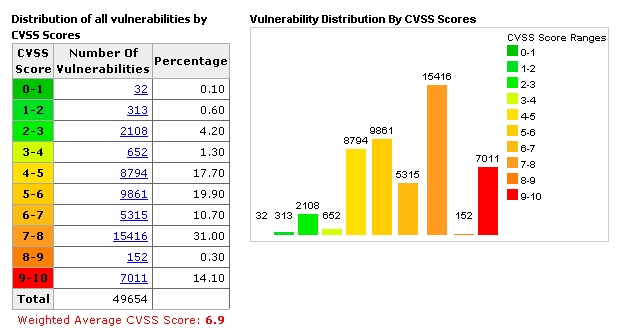
None - white (0.0)
Low - green tones (0.1 - 3.9)
Medium - yellow/light orange (4.0 - 4.9)
High - orange (7.0 - 8.0)
Critical - red (9.0 - 10.0)
CVE – Common Vulnerabilities and Exposures [+]
Is a list of publicly disclosed vulnerabilities and exposures that is maintained by MITRE.

NVD - National Vulnerability Database [+]
is a database, maintained by NIST, that is fully synchronized with the MITRE CVE list; US Gov. vulnerabilities repository.
ProxyChains ⛓

ProxyChains is open-source software that is available free and most of Linux distro it is pre-installed. If you are using the latest version of Kali Linux it is pre-installed in it.
ProxyChains is a tool that redirects the TCP (Transmission Control Protocol) connection with the help of proxies like TOR, HTTP(S), and SOCKS, and it creates a proxy chain server.
ProxyChains Features:
Support SOCKS5, SOCKS4, and HTTP/HTTPS CONNECT proxy servers.
Proxychains can be mixed up with a different proxy types in a list
Proxychains also supports any kinds of chaining option methods, like: random, which takes a random proxy in the list stored in a configuration file, or chaining proxies in the exact order list, different proxies are separated by a new line in a file. There is also a dynamic option, that lets Proxychains go through the live only proxies, it will exclude the dead or unreachable proxies, the dynamic option often called smart option.
Proxychains can be used with servers, like squid, sendmail, etc.
Proxychains is capable to do DNS resolving through proxy.
Proxychains can handle any TCP client application, ie., nmap, telnet.
Enumeration Concepts
Enumeration is the process of extracting user names, machine names, network resources, shares, and services from a system, and its conducted in an intranet environment.
Get user names using email IDs
Get information using default passwords
Get user names using SNMP
Brute force AD
Get user groups from Windows
Get information using DNS zone transfers
NetBios, LDAP, NTP, DNS
In this phase, the attacker creates an active connection to the system and performs directed queries to gain more information about the target. The gathered information is used to identify the vulnerabilities or weak points in system security and tries to exploit in the System gaining phase.
Defined as listing the items that are found within a specific target
Always is active in nature
Direct access
Gain more information
SNMP Enumeration
⚡︎ Check the SNMP Enumeration practical lab
SNMP enumeration is the process of enumerating the users accounts and devices on a SNMP enabled computer.
SNMP service comes with two passwords, which are used to configure and access the SNMP agent from the management station (MIB):
Read community string
Read/Write community string
These strings (
passwords) come with a default value, which is same for all the systems.They become easy entry points for attackers if left unchanged by administrator.
Attackers enumerate SNMP to extract information about network resources such as hosts, routers, devices, shares(...) Network information such as ARP tables, routing tables, device specific information and traffic statistics.
Runs on Port 161 UDP
Management Information Base (MIB) - database that stores information
Object Identifiers (OID) - identifiers for information stored in MIB
SNMP GET - gets information about the system
SNMP SET - sets information about the system
Types of objects
Scalar - single object
Tabular - multiple related objects that can be grouped together
SNMP uses community strings which function as passwords
There is a read-only and a read-write version
Default read-only string is public and default read-write is private
These are sent in cleartext unless using SNMP v3
CLI Tools
snmp-check--> SNMP device enumerator comes pre-installed on Kali Linux machine; snmp-check supports a huge type of enumerations:contact and user accounts
devices
domain
hardware and storage informations
hostname
IIS statistics
listening UDP ports and TCP connections
motd (banner)
network interfaces and network services
routing information
etc
Metasploit module
snmp_enumsnmpwalk
GUI Tools
Engineer's Toolset
SNMPScanner
OpUtils 5
SNScan
Example of SNScan:
Note: the first scanned item is a printer running SNMP.
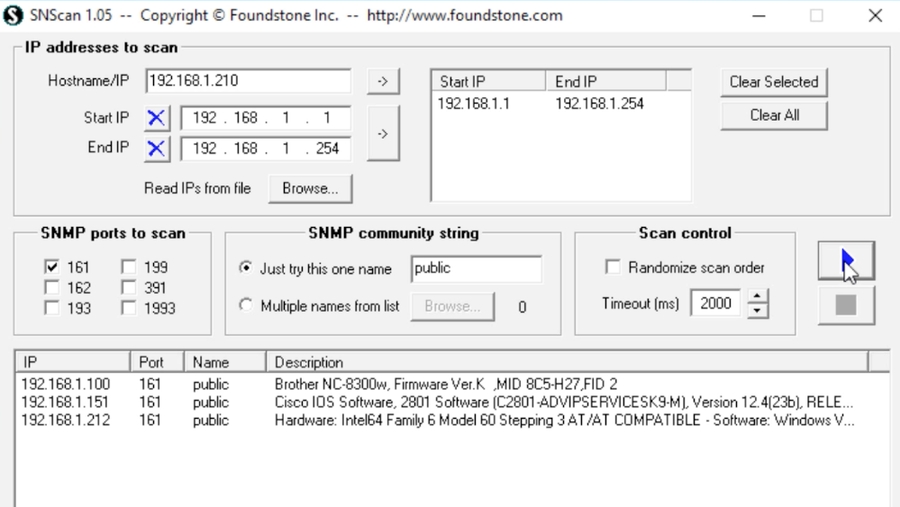
Windows System Basics
Everything runs within context of an account
Security Context - user identity and authentication information
Security Identifier (SID) - identifies a user, group or computer account
Resource Identifier (RID) - portion of the SID identifying a specific user, group or computer
The end of the SID indicates the user number
Example SID: S-1-5-21-3874928736-367528774-1298337465-500
Administrator Account - SID of 500
Command to get SID of local user:
wmic useraccount where name='username' get sid
Regular Accounts - start with a SID of 1000
Linux Systems used user IDs (UID) and group IDs (GID). Found in /etc/passwd
SAM Database - file where all local passwords are stored (encrypted)
Stored in C:\Windows\System32\Config
Linux Enumeration Commands in PowerShell or CmdPrompt
finger- info on user and host machinerpcinfoandrpcclient- info on RPC in the environmentshowmount- displays all shared directories on the machine
Look for share resources (NetBIOS):
net view \\sysName
Windows SysInternals is a website and suite that offers technical resources and utilities to manage, diagnose, troubleshoot, and monitor.
https://docs.microsoft.com/en-us/sysinternals/downloads/
Lots of resources for enumerating, windows administration tools, etc.
NetBIOS Enumeration
NetBIOS provides name servicing, connectionless communication and some Session layer stuff
The browser service in Windows designed to host information about all machines within domain or TCP/IP network segment
NetBIOS name is a 16-character ASCII string used to identify devices
Enumerating NetBIOS:
You can use
nmap or zenmapto check which OS the target is using, and which ports are open:nmap -O <target>
If theres any UDP port 137 or TCP port 138/139 open, we can assume that the target is running some type of NetBIOS service.
On Windows is
nbtstatcommand:
nbtstat displays protocol statistics and current TCP/IP connections using NetBIOS over TCP/IP.
nbtstatgives your own infonbtstat -alist the remote machine's name table given its namenbtstat -A- list the remote machine's name table given its IP addressnbtstat -ngives local tablenbtstat -cgives cache information
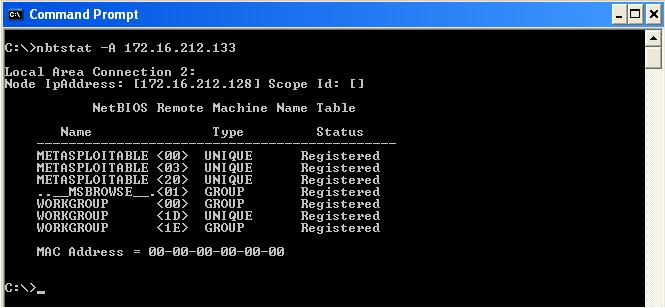
<1B>
UNIQUE
Domain master browser
<1C>
UNIQUE
Domain controller
<1D>
GROUP
Master browser for subnet
<00>
UNIQUE
Hostname
<00>
GROUP
Domain name
<03>
UNIQUE
Service running on system
<20>
UNIQUE
Server service running
NetBIOS name resolution doesn't work on IPv6
Other Tools for NetBIOS enumeration:
SuperScan
Hyena
NetBIOS Enumerator (is a nbtstat with GUI)
NSAuditor
Linux System Basics
Enum4linuxis a tool for enumerating information from Windows and Samba systems:enum4linux -u CEH -p Pa55w0rd -U 10.0.2.23-uUsername,-pPassword,-Uusers information
Key features:
RID cycling (When RestrictAnonymous is set to 1 on Windows 2000)
User listing (When RestrictAnonymous is set to 0 on Windows 2000)
Listing of group membership information
Share enumeration
Detecting if host is in a workgroup or a domain
Identifying the remote operating system
Password policy retrieval (using polenum)
finger--> who is currently logged in, when and where.Login Name Tty Idle Login Time Office Office Phone kali Kali tty7 10:09 Sep 1 14:14 (:0)w--> Show who is logged on and what they are doing.00:27:15 up 9:32, 1 user, load average: 0.06, 0.09, 0.09 USER TTY FROM LOGIN@ IDLE JCPU PCPU WHAT kali tty7 :0 14:16 10:11m 30.26s 2.09s xfce4-session
⚠️ Linux architecture and commands will be cover later on next module.
LDAP Enumeration
Runs on TCP ports 389 and 636 (over SSL)
Connects on 389 to a Directory System Agent (DSA)
Returns information such as valid user names, domain information, addresses, telephone numbers, system data, organization structure and other items
To identify if the target system is using LDAP services you can use nmap with
-sTflag for TCP connect/Full scan and-Oflag for OS detection.
sudo nmap -sT -O <target IP address>
PORT STATE SERVICE
53/tcp open domain
88/tcp open kerberos-sec
135/tcp open msrpc
139/tcp open netbios-ssn
389/tcp open ldap <--------------------------------------
445/tcp open microsoft-ds
464/tcp open kpasswd5
593/tcp open http-rpc-epmap
636/tcp open ldapssl <--------------------------------------
3268/tcp open globalcatLDAP
3269/tcp open globalcatLDAPssl
49154/tcp open unknown
49155/tcp open unknown
49157/tcp open unknown
49158/tcp open unknown
49159/tcp open unknown
MAC Address: 00:00:11:33:77:44
Running: Microsoft Windows 2012
OS CPE: cpe:/o:microsoft:windows_server_2012:r2
OS details: Microsoft Windows Server 2012 or Windows Server 2012 R2
Network Distance: 1 hopTools for Enumeration LDAP:
Softerra
JXplorer
Lex
LDAP Admin Tool
JXplorer example:
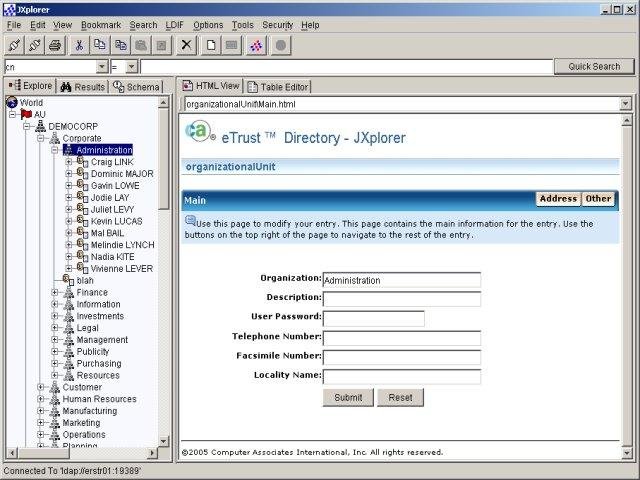
NTP Enumeration
Runs on UDP 123
Querying can give you list of systems connected to the server (name and IP)
Tools
NTP Server Scanner
AtomSync
Can also use Nmap and Wireshark
Commands include
ntptrace,ntpdate,ntpdcandntpq
Nmap example for NTP enumeration:
-sUUDP scan-pUport UDP 123 (NTP)-PnTreat all hosts as online -- skip host discovery-nNever do DNS resolutionThe nmap script
ntp-monlistwill run against the ntp service which only runs on UDP 123
nmap -sU -pU:123 -Pn -n --script=ntp-monlist <target>
PORT STATE SERVICE REASON
123/udp open ntp udp-response
| ntp-monlist:
| Target is synchronised with 127.127.38.0 (reference clock)
| Alternative Target Interfaces:
| 10.17.4.20
| Private Servers (0)
| Public Servers (0)
| Private Peers (0)
| Public Peers (0)
| Private Clients (2)
| 10.20.8.69 169.254.138.63
| Public Clients (597)
| 4.79.17.248 68.70.72.194 74.247.37.194 99.190.119.152
| ...
| 12.10.160.20 68.80.36.133 75.1.39.42 108.7.58.118
| 68.56.205.98
| 2001:1400:0:0:0:0:0:1 2001:16d8:dd00:38:0:0:0:2
| 2002:db5a:bccd:1:21d:e0ff:feb7:b96f 2002:b6ef:81c4:0:0:1145:59c5:3682
| Other Associations (1)
|_ 127.0.0.1 seen 1949869 times. last tx was unicast v2 mode 7As you can see on the output above, information of all clients that is using NTP services on the network shown IPv4 and IPv6 addresses.
SMTP Enumeration
Ports used:
SMTP: TCP 25 --> [outbound email]
IMAP: TCP 143 / 993(over SSL) --> [inbound email]
POP3: TCP 110 / 995(over SSL) --> [inbound email]
In simple words: users typically use a program that uses SMTP for sending e-mail and either POP3 or IMAP for receiving e-mail.
Enumerating with nmap:
-p25port 25 (SMTP)--script smtp-commandsnmap script - attempts to use EHLO and HELP to gather the Extended commands supported by an SMTP server.
nmap -p25 --script smtp-commands <target IP>
PORT STATE SERVICE
25/tcp open smtp
| smtp-commands: WIN-J83C1DR5CV1.ceh.global Hello [10.10.10.10], TURN, SIZE 2097152, ETRN, PIPELINING, DSN, ENHANCEDSTATUSCODES, 8bitmime, BINARYMIME, CHUNKING, VRFY, OK,
|_ This server supports the following commands: HELO EHLO STARTTLS RCPT DATA RSET MAIL QUIT HELP AUTH TURN ETRN BDAT VRFY
Nmap done: 1 IP address (1 host up) scanned in 0.86 secondsIt is possible to connect to SMTP through Telnet connection, instead using port 23(Telnet) we can set the port 25(SMTP) on the telnet command:
telnet <target> 25Case we got connected, we can use the SMTP commands to explore as shown below:
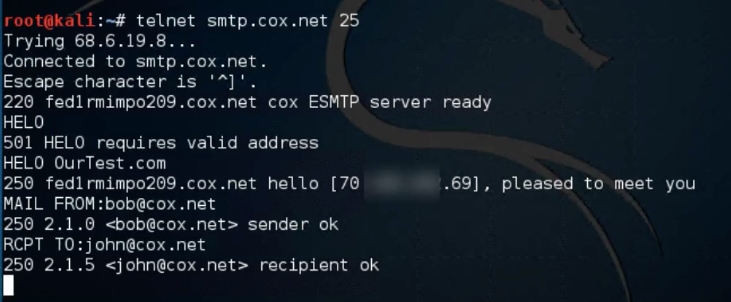
Both of emails are valid to an attacker explore further attacks like brute forcing etc.
Some SMTP Commands:
HELO
It’s the first SMTP command: is starts the conversation identifying the sender server and is generally followed by its domain name.
EHLO
An alternative command to start the conversation, underlying that the server is using the Extended SMTP protocol.
MAIL FROM
With this SMTP command the operations begin: the sender states the source email address in the “From” field and actually starts the email transfer.
RCPT TO
It identifies the recipient of the email
DATA
With the DATA command the email content begins to be transferred; it’s generally followed by a 354 reply code given by the server, giving the permission to start the actual transmission.
VRFY
The server is asked to verify whether a particular email address or username actually exists.
EXPN
asks for a confirmation about the identification of a mailing list.
Other tools:
smtp-user-enum
Username guessing tool primarily for use against the default Solaris SMTP service. Can use either EXPN, VRFY or RCPT TO.
Last updated